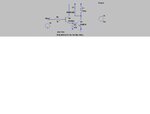Houssem85
Newbie level 5
Hello ,
I designed a power amplifier so that it plays the role of interface between my STM32 microcontroller and a pump (12V 1A).
This circuit is a good power amplifier which helped me to control this motor from the microcontroller which inject into the input a PWM 3.3V.
My question here is this:
I want to provide a more comfortable current (and voltage ) to the motor, so I change R1, or R9 or R6... ? and Why?
Vcc = 12V
Please give me a change in the circuit, so that the motor runs better.
Can you help me ??
Here attached the circuit of the power amplifier.

I designed a power amplifier so that it plays the role of interface between my STM32 microcontroller and a pump (12V 1A).
This circuit is a good power amplifier which helped me to control this motor from the microcontroller which inject into the input a PWM 3.3V.
My question here is this:
I want to provide a more comfortable current (and voltage ) to the motor, so I change R1, or R9 or R6... ? and Why?
Vcc = 12V
Please give me a change in the circuit, so that the motor runs better.
Can you help me ??
Here attached the circuit of the power amplifier.

